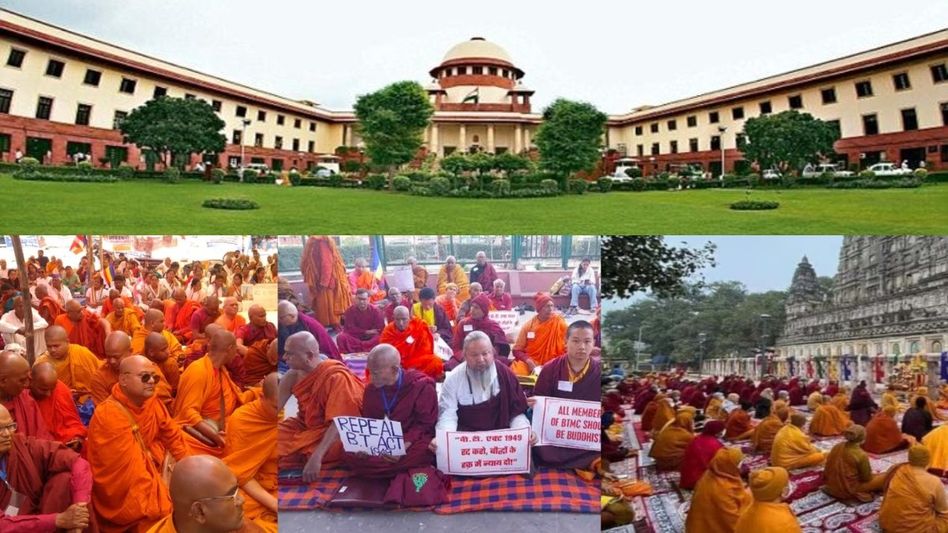Sikkim’s Buddhists eye relief as SC set to examine Bodh Gaya Temple Act challenge
The Supreme Court of India considers a petition challenging the Bodh Gaya Temple Act of 1949. Sikkim's Buddhists seek greater control over the Mahabodhi Temple's management. The case represents a significant hope for restoring Buddhist representation.

- Supreme Court issued notice to central government on temple law petition
- Petition claims 1949 Act is unconstitutional and outdated
- Mahabodhi Temple is a UNESCO World Heritage Site and spiritual centre
The Supreme Court of India will look into a petition seeking to repeal the Bodh Gaya Temple Act of 1949. The petition also demands that a new central law be created to ensure better control, management, and administration of the Mahabodhi Temple, one of Buddhism’s most sacred places located in Bihar.
A bench of Justices M M Sundresh and N Kotiswar Singh heard the plea on Monday. The court issued a notice to the central government and other concerned authorities, asking them to respond to the petition. The court also said it would hear the case along with a similar petition that is already pending.
The petition challenges the validity of the Bodh Gaya Temple Act, 1949, calling it "unconstitutional" and “inconsistent” with Article 13 of the Indian Constitution. Article 13 states that any law which takes away or limits the fundamental rights of citizens shall be considered void.
The petitioners argued that the 1949 Act is outdated and does not properly represent the religious interests of Buddhists, for whom Bodh Gaya holds deep spiritual meaning. The Mahabodhi Temple, where Lord Gautam Buddha is believed to have attained enlightenment over 2,500 years ago, is visited by Buddhists from all over the world. It is also a UNESCO World Heritage Site.
According to the petition, the temple is not just a historical place but a living center of faith and worship for millions of Buddhists. Therefore, they believe it should be governed under a central law that ensures its exclusive use for Buddhist religious activities and protects it from mismanagement and encroachment.
The petitioners also raised concerns about alleged encroachments on the temple premises. They asked the court to direct authorities to remove any such encroachments in order to maintain the sanctity of the temple and give Buddhists full and unhindered access to their place of worship.
It is important to note that the Supreme Court had earlier, on June 30, refused to hear a different plea that also challenged the 1949 Act. In that case, the court advised the petitioner to approach the concerned High Court instead. However, this time the top court has agreed to take up the issue itself, giving fresh hope to those who want the temple to be governed under a new national law.
The Mahabodhi Temple Complex includes a tall main temple structure that is 50 meters high, the Vajrasana or “Diamond Throne,” the sacred Bodhi tree under which Buddha meditated, and several smaller stupas and holy sites. The entire complex is carefully maintained and protected by boundary walls, and it lies around five meters below the surrounding land level. A seventh sacred place, the Lotus Pond, lies just outside the temple enclosure on the southern side.
Why Sikkim's Buddhist Hope for Relief ?
Buddhists in Sikkim have been deeply involved in this cause for months. The Sikkim Chapter of the All India Buddhist Forum organized a large peace rally in Gangtok on April 26, 2025, to support the repeal of the 1949 Act. The rally saw about 500 supporters walking through the main streets in solidarity with ongoing protests in Bodh Gaya.
Sikkim’s Minister for Ecclesiastical Affairs, Sonam Lama, also formally wrote to the Union Government on April 1, requesting intervention. He emphasized that Buddhists worldwide seek fair representation in the temple’s governance
Monks and community leaders from Sikkim have joined dharnas and sit‑ins in Bodh Gaya, demanding amendments to the temple law.Tribal organizations and Sikkim’s Buddhist communities back the demand for reform, stressing that control of their holy site should rest with Buddhists alone.
For the people of Sikkim, the court’s decision to hear this case offers hope. They believe that a new central law or an amendment to the old Act can bring real relief. Many feel it would help restore full Buddhist representation in the management of the temple so that the decisions are made by those who truly understand its spiritual importance. They also think it will ensure that religious control stays in the hands of Buddhists, who have a deep connection to Bodh Gaya. Most importantly, they hope it will protect the sanctity of this sacred place for Buddhists in Sikkim and all over the world.
Copyright©2025 Living Media India Limited. For reprint rights: Syndications Today









